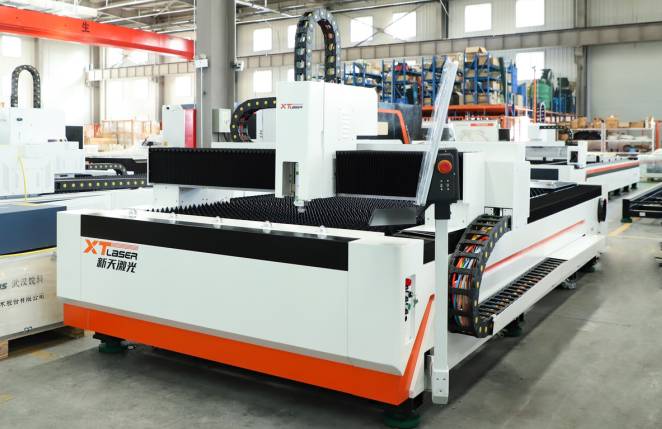 English
English Español
Español  Português
Português  русский
русский  Français
Français  日本語
日本語  Deutsch
Deutsch  tiếng Việt
tiếng Việt  Italiano
Italiano  Nederlands
Nederlands  ภาษาไทย
ภาษาไทย  Polski
Polski  한국어
한국어  Svenska
Svenska  magyar
magyar  Malay
Malay  বাংলা ভাষার
বাংলা ভাষার  Dansk
Dansk  Suomi
Suomi  हिन्दी
हिन्दी  Pilipino
Pilipino  Türkçe
Türkçe  Gaeilge
Gaeilge  العربية
العربية  Indonesia
Indonesia  Norsk
Norsk  تمل
تمل  český
český  ελληνικά
ελληνικά  український
український  Javanese
Javanese  فارسی
فارسی  தமிழ்
தமிழ்  తెలుగు
తెలుగు  नेपाली
नेपाली  Burmese
Burmese  български
български  ລາວ
ລາວ  Latine
Latine  Қазақша
Қазақша  Euskal
Euskal  Azərbaycan
Azərbaycan  Slovenský jazyk
Slovenský jazyk  Македонски
Македонски  Lietuvos
Lietuvos  Eesti Keel
Eesti Keel  Română
Română  Slovenski
Slovenski  मराठी
मराठी  Srpski језик
Srpski језик
Laser Cutting Machine Cutting Quality Analysis
2022-04-11
The quality of the laser cutting machine mainly depends on its cutting quality, which is the most direct way to check the quality of the equipment. For new customers, when purchasing equipment, they will be asked to look at the laser cutting machine proofing first. In addition to the cutting speed of the equipment, the proofing depends on the cutting quality of the sample. How to look at the cutting quality and what aspects should be paid attention to? The following will give you a detailed introduction.
 1. Roughness
1. Roughness
The laser cutting section will form vertical lines, and the depth of the lines determines the roughness of the cutting surface. The shallower the lines, the smoother the cutting section. Roughness affects not only the appearance of the edge, but also the friction characteristics. In most cases, the roughness needs to be minimized, so the shallower the texture, the better the cut quality.
2. Verticality
When the thickness of the sheet metal exceeds 10mm, the verticality of the cutting edge is very important. As you move away from the focal point, the laser beam becomes divergent and the cut widens towards the top or bottom depending on the position of the focal point. The cutting edge deviates from the vertical line by a few percent of a millimeter, the more vertical the edge, the higher the cutting quality.
3.Cutting width
Generally speaking, the width of the cut does not affect the quality of the cut. It is only when a particularly precise contour is formed inside the part that the width of the cut has an important effect. This is because the width of the cut determines the minimum inner diameter of the contour. of increase. Therefore, in order to ensure the same high precision, the workpiece should be constant in the processing area of the laser cutting machine regardless of the width of the incision.
4. Texture
When cutting thick plates at high speed, the molten metal does not appear in the incision under the vertical laser beam, but sprays out at the back of the laser beam. As a result, curved lines are formed at the cutting edge, and the lines closely follow the moving laser beam. To correct this problem, reducing the feed rate at the end of the cutting process can greatly eliminate the formation of lines.
5. Glitch
The formation of burrs is a very important factor that determines the quality of laser cutting. Because the removal of burrs requires extra workload, the severity and amount of burrs can intuitively judge the quality of cutting.
www.xtlaser.com
xintian152@xtlaser.com
WA: +86 18206385787

The laser cutting section will form vertical lines, and the depth of the lines determines the roughness of the cutting surface. The shallower the lines, the smoother the cutting section. Roughness affects not only the appearance of the edge, but also the friction characteristics. In most cases, the roughness needs to be minimized, so the shallower the texture, the better the cut quality.
2. Verticality
When the thickness of the sheet metal exceeds 10mm, the verticality of the cutting edge is very important. As you move away from the focal point, the laser beam becomes divergent and the cut widens towards the top or bottom depending on the position of the focal point. The cutting edge deviates from the vertical line by a few percent of a millimeter, the more vertical the edge, the higher the cutting quality.
3.Cutting width
Generally speaking, the width of the cut does not affect the quality of the cut. It is only when a particularly precise contour is formed inside the part that the width of the cut has an important effect. This is because the width of the cut determines the minimum inner diameter of the contour. of increase. Therefore, in order to ensure the same high precision, the workpiece should be constant in the processing area of the laser cutting machine regardless of the width of the incision.
4. Texture
When cutting thick plates at high speed, the molten metal does not appear in the incision under the vertical laser beam, but sprays out at the back of the laser beam. As a result, curved lines are formed at the cutting edge, and the lines closely follow the moving laser beam. To correct this problem, reducing the feed rate at the end of the cutting process can greatly eliminate the formation of lines.
5. Glitch
The formation of burrs is a very important factor that determines the quality of laser cutting. Because the removal of burrs requires extra workload, the severity and amount of burrs can intuitively judge the quality of cutting.
www.xtlaser.com
xintian152@xtlaser.com
WA: +86 18206385787
We use cookies to offer you a better browsing experience, analyze site traffic and personalize content. By using this site, you agree to our use of cookies.
Privacy Policy





